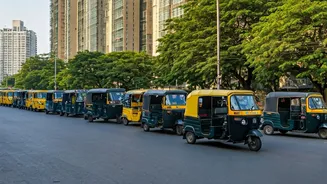The Current Situation
Mumbai's auto and taxi services were poised to face potential disruptions. Several factors, including operational issues, were contributing to this situation,
creating a ripple effect across the city's transport network. This news came amidst other city developments, prompting many to wonder about the city's overall connectivity and ease of commute. The services play an essential part of the daily life for many Mumbaikars, making any potential changes to the accessibility or pricing of these services a significant concern. The impact of such changes could be felt by a wide range of people, from those who regularly use the services for commuting to those who depend on them for their livelihood. Therefore, understanding the scope of these disruptions, the causes behind them, and the likely impact is of utmost importance for everyone living in the city.
Key Contributing Factors
Several elements were at play, contributing to the possibility of disruption in Mumbai's auto and taxi services. Various operational challenges were expected to be at the forefront. These include possible strike actions, fuel price fluctuations, and regulatory changes which all impacted the daily functioning and economic viability of auto and taxi operators. Furthermore, technological advancements and the rise of app-based transportation services have also played a role, adding another layer of complexity. These factors, acting alone or in combination, created an uncertain environment for the services. Fuel price hikes, in particular, often lead to calls for fare adjustments. Meanwhile, app-based competitors also put pressure on traditional auto and taxi operators. Understanding these contributing factors is vital for comprehending the broader dynamics at work within the city's transportation sector.
Impact on Commuters
The possible disruption of auto and taxi services had the potential to create a cascade of difficulties for commuters across Mumbai. The most immediate impact could be on the availability of transport, meaning it might be harder to find an auto or taxi, or that there might be delays in securing one. This would likely cause chaos for daily commuters, office-goers, students, and anyone relying on these services to get around. Additionally, if the situation caused fare adjustments, commuters could face higher costs for their travel. This has significant implications for people from various economic backgrounds. People with lower income might struggle, and it could also affect the daily expenses of many residents. The possible disruption posed significant inconvenience and financial burdens for those who rely on autos and taxis every day.
Broader Implications Examined
The potential disruption went beyond just the immediate impact on commuters; it could have broader implications for the city of Mumbai and its economy. The transportation sector is a crucial part of the economy, and the changes to the availability and affordability of services could have a far-reaching influence. Businesses, for example, could see an impact if their employees face transportation problems, affecting productivity and business operations. The disruptions might also influence tourism, as tourists depend on autos and taxis to discover the city. The overall impact on the city's image and ability to function smoothly is a real possibility. Moreover, this situation could highlight the need for a well-rounded and reliable public transport system, promoting the need for smart transport options.
What to Expect
As Mumbai's auto and taxi services faced possible disruption, the anticipation for those relying on the service was very high. Commuters needed to prepare for possible delays and inconveniences. It was advised that commuters should seek alternatives where possible, such as using public transport. Keeping up-to-date with the latest developments through news outlets and official announcements became very important. Commuters could also consider carpooling or using app-based services. Planning ahead and being informed will help mitigate the impact of the possible disruption. Keeping an eye out for news, taking pre-emptive steps, and being open to alternate means of transport became a necessity for navigating this situation.


















